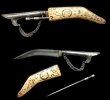- Joined
- Oct 11, 2000
- Messages
- 372
It's true I am a khukuri fan with about ten khuks to my name, but my latest acquisition was a (wait for it) jambiya! So why a jambiya? Well, it makes sense, doesn't it? When I show my khuks to my friends, I tell them the khuk is the traditional knife of the Gurkhas. So, in contrast/similarity (?) with the khuk there are other knives also known as traditional in their own country. The jambiya is one of those. Many countries from Morocco eastwards to Bali claim the jambiya as their traditional knife. The one I managed to acquire is a Kurdish jambiya of about 1910 vintage. So I think you actually highlight the status or position of the khukuri by comparing it with eg. the jambiya.
How does that grab you, guys? Stay well.
(Joke: There was this father who complained about his little son's messy table manners. He said to his son, "You eat like a little pig, you know! Do you know what a little pig is?" The son replied: "Yes, Daddy. It's the little boy of a big pig!"
How does that grab you, guys? Stay well.
(Joke: There was this father who complained about his little son's messy table manners. He said to his son, "You eat like a little pig, you know! Do you know what a little pig is?" The son replied: "Yes, Daddy. It's the little boy of a big pig!"







